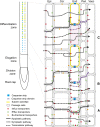Beyond the barrier: communication in the root through the endodermis
- PMID: 25125504
- PMCID: PMC4213087
- DOI: 10.1104/pp.114.244871
Beyond the barrier: communication in the root through the endodermis
Abstract
The root endodermis is characterized by the Casparian strip and by the suberin lamellae, two hydrophobic barriers that restrict the free diffusion of molecules between the inner cell layers of the root and the outer environment. The presence of these barriers and the position of the endodermis between the inner and outer parts of the root require that communication between these two domains acts through the endodermis. Recent work on hormone signaling, propagation of calcium waves, and plant-fungal symbiosis has provided evidence in support of the hypothesis that the endodermis acts as a signaling center. The endodermis is also a unique mechanical barrier to organogenesis, which must be overcome through chemical and mechanical cross talk between cell layers to allow for development of new lateral organs while maintaining its barrier functions. In this review, we discuss recent findings regarding these two important aspects of the endodermis.
© 2014 American Society of Plant Biologists. All Rights Reserved.
Figures


References
-
- Akiyama K, Matsuzaki K, Hayashi H. (2005) Plant sesquiterpenes induce hyphal branching in arbuscular mycorrhizal fungi. Nature 435: 824–827 - PubMed
-
- Alassimone J, Roppolo D, Geldner N, Vermeer JE. (2012) The endodermis: development and differentiation of the plant’s inner skin. Protoplasma 249: 433–443 - PubMed
-
- Allen GJ, Chu SP, Harrington CL, Schumacher K, Hoffmann T, Tang YY, Grill E, Schroeder JI. (2001) A defined range of guard cell calcium oscillation parameters encodes stomatal movements. Nature 411: 1053–1057 - PubMed
Publication types
MeSH terms
Substances
LinkOut - more resources
Full Text Sources
Other Literature Sources

